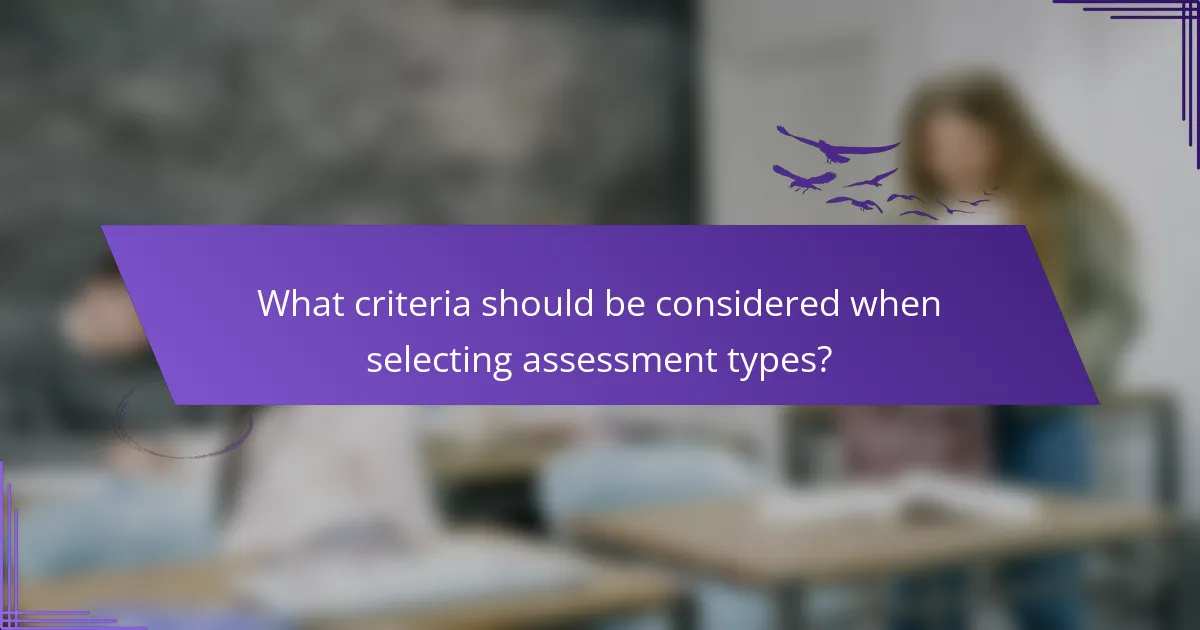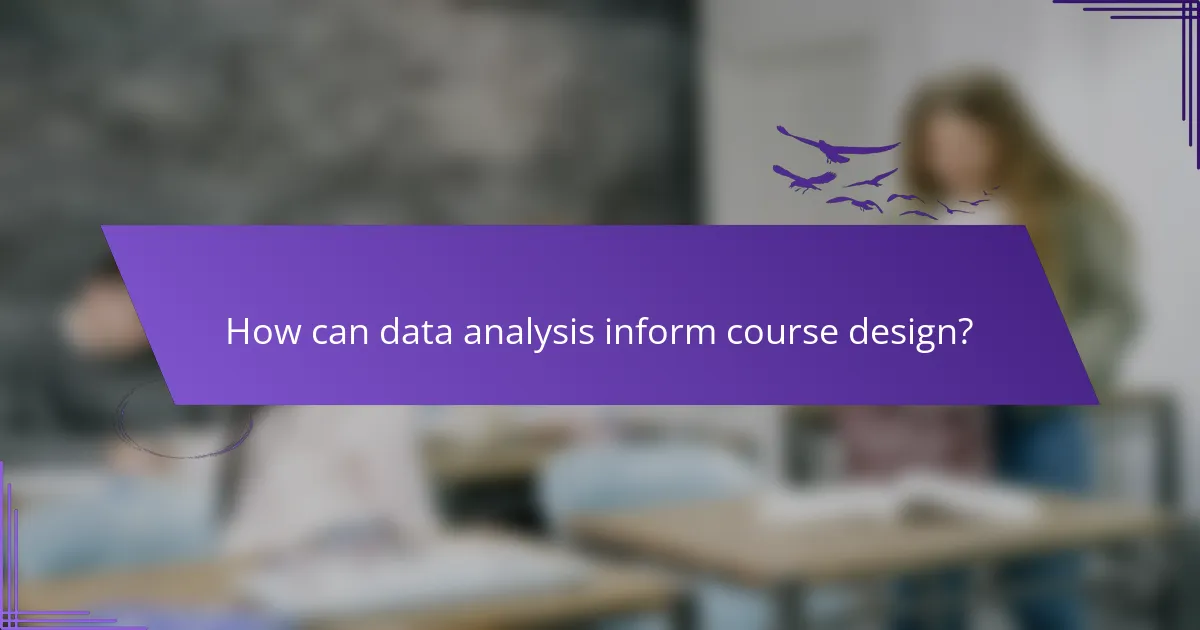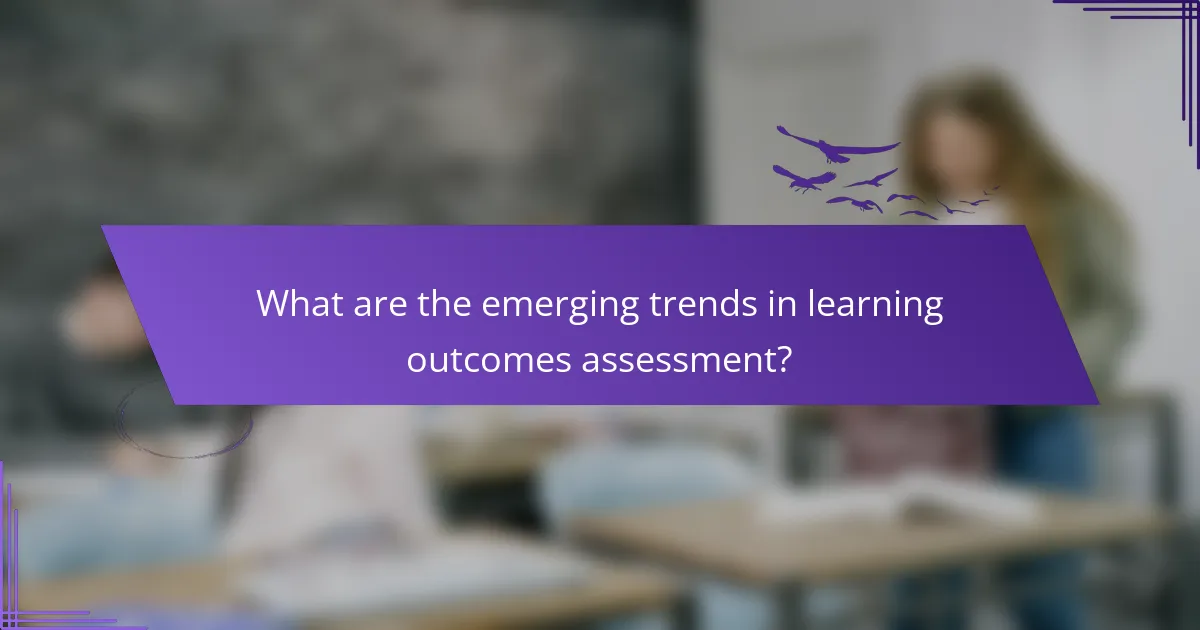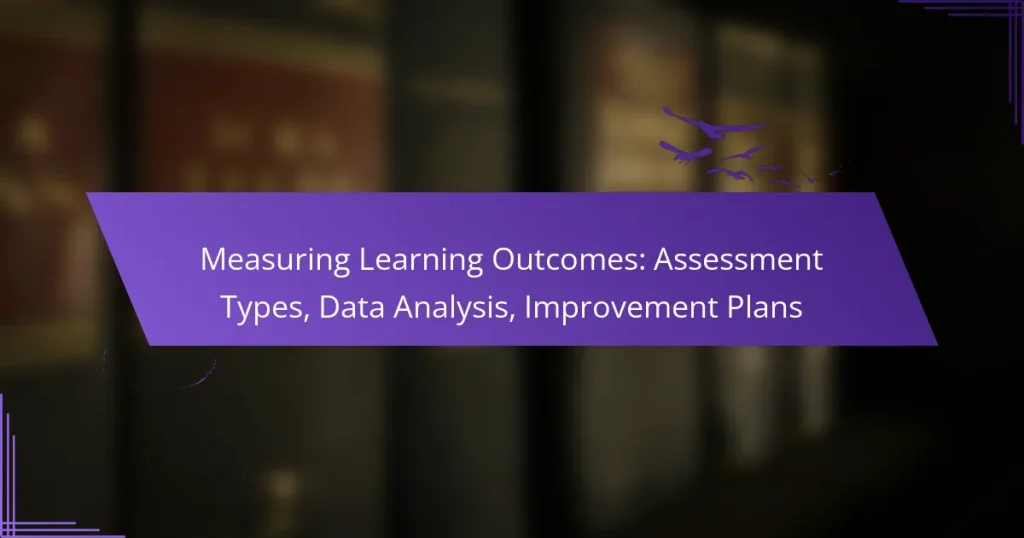Measuring learning outcomes is essential for understanding student performance and enhancing educational effectiveness. By utilizing various assessment types, educators can evaluate student comprehension and pinpoint areas needing improvement. Data analysis plays a crucial role in this process, employing both quantitative and qualitative methods to inform targeted improvement plans.

How can online courses measure learning outcomes?
Online courses can measure learning outcomes through various assessment types that evaluate student performance and understanding. These assessments provide insights into what learners have grasped and identify areas for improvement.
Formative assessments
Formative assessments are ongoing evaluations that occur during the learning process. They help instructors gauge student understanding and adjust teaching methods accordingly. Examples include quizzes, discussions, and interactive activities that provide immediate feedback.
These assessments are typically low-stakes, allowing students to learn from their mistakes without the pressure of final grades. Incorporating regular formative assessments can enhance engagement and retention of material.
Summative assessments
Summative assessments occur at the end of a learning period to evaluate overall student achievement. Common forms include final exams, projects, or standardized tests that measure cumulative knowledge. These assessments often carry significant weight in grading.
While they provide a clear picture of learning outcomes, summative assessments may not reflect ongoing student progress. Balancing them with formative assessments can create a more comprehensive evaluation strategy.
Peer assessments
Peer assessments involve students evaluating each other’s work, fostering collaboration and critical thinking. This method encourages learners to engage with the material and develop a deeper understanding through discussion and feedback.
Implementing peer assessments can be beneficial, but it requires clear guidelines to ensure constructive criticism. Providing rubrics can help standardize evaluations and enhance the learning experience.
Self-assessments
Self-assessments allow students to reflect on their own learning and identify strengths and weaknesses. This process encourages personal accountability and helps learners take ownership of their educational journey.
Tools such as reflective journals or checklists can facilitate self-assessment. However, students may need guidance on how to evaluate their performance objectively to maximize the benefits of this approach.
Standardized tests
Standardized tests are uniform assessments designed to measure student performance against a common benchmark. They are often used in educational systems to evaluate learning outcomes across different institutions.
While standardized tests can provide valuable data for comparison, they may not capture the full scope of a student’s abilities. It’s essential to complement these tests with other assessment types to gain a more holistic view of learning outcomes.

What types of data analysis are used in learning outcomes assessment?
Data analysis in learning outcomes assessment primarily involves quantitative and qualitative methods to evaluate educational effectiveness. These analyses help educators understand student performance, identify trends, and inform improvement strategies.
Quantitative analysis
Quantitative analysis focuses on numerical data to assess learning outcomes. This method often employs standardized tests, surveys, and metrics to measure student performance and achievement levels. For example, a school might analyze test scores to determine the percentage of students meeting proficiency standards.
When conducting quantitative analysis, it is crucial to ensure data accuracy and reliability. Common pitfalls include using outdated assessment tools or failing to account for demographic variables that may influence results. Regularly reviewing and updating assessment methods can enhance the validity of findings.
Qualitative analysis
Qualitative analysis examines non-numerical data to gain insights into student experiences and perceptions. This approach often involves interviews, focus groups, and open-ended survey questions that allow for deeper exploration of learning outcomes. For instance, educators might analyze student feedback to identify areas for curriculum improvement.
To effectively conduct qualitative analysis, it is essential to use systematic coding and thematic analysis techniques. This ensures that findings are organized and can be compared across different groups or time periods. Engaging diverse stakeholders in the analysis process can also enrich the insights gained.
Descriptive statistics
Descriptive statistics summarize and describe the main features of a data set, providing a clear overview of learning outcomes. Common measures include mean, median, mode, and standard deviation, which help educators understand central tendencies and variability in student performance.
Using descriptive statistics allows for quick comparisons between different groups or time periods. For example, educators can compare average test scores across different classes or track changes in performance over several semesters. However, it is important to avoid overgeneralizing findings based solely on descriptive statistics.
Inferential statistics
Inferential statistics enable educators to make predictions or inferences about a larger population based on sample data. This method often involves hypothesis testing and confidence intervals, allowing for conclusions about the effectiveness of educational interventions or programs.
When applying inferential statistics, it is vital to ensure that samples are representative of the population. Misleading conclusions can arise from biased sampling or incorrect assumptions. Educators should also be cautious in interpreting results, as statistical significance does not always imply practical significance in educational contexts.

How do improvement plans enhance learning outcomes?
Improvement plans enhance learning outcomes by systematically identifying areas for growth and implementing targeted strategies. These plans focus on refining educational practices, ensuring that both curriculum and instruction are aligned with desired learning objectives.
Curriculum adjustments
Curriculum adjustments are essential for enhancing learning outcomes as they allow educators to tailor content to meet student needs. This may involve revising lesson plans, integrating new resources, or adopting different teaching methodologies. For example, incorporating project-based learning can engage students more effectively than traditional lectures.
Instructor training
Instructor training is crucial for improving educational effectiveness and ensuring that teachers are equipped with the latest pedagogical strategies. Regular professional development sessions can help instructors learn new techniques and stay updated on educational trends. Investing in training can lead to a more dynamic classroom environment, ultimately benefiting student engagement and performance.
Feedback mechanisms
Feedback mechanisms provide valuable insights into student progress and areas needing improvement. Implementing regular assessments, surveys, and one-on-one discussions can help educators gauge understanding and adjust their teaching accordingly. Establishing a culture of open feedback encourages students to take an active role in their learning, fostering a more collaborative educational atmosphere.

What criteria should be considered when selecting assessment types?
When selecting assessment types, it is essential to consider alignment with learning objectives, the demographics of the student population, and the resources available for implementation. These factors ensure that assessments are effective, equitable, and feasible within the educational context.
Learning objectives alignment
Assessments should directly align with the learning objectives set for the course or program. This alignment ensures that the assessments measure what students are expected to learn, providing valid data on their progress. For example, if a learning objective focuses on critical thinking, assessments should include tasks that require analysis and evaluation rather than rote memorization.
When evaluating alignment, consider using backward design principles, where assessments are developed after defining clear learning outcomes. This approach helps in creating assessments that are not only relevant but also meaningful for both students and educators.
Student demographics
Understanding student demographics is crucial when selecting assessment types, as it influences how students engage with the material and demonstrate their knowledge. Factors such as age, cultural background, and prior educational experiences can affect students’ performance on different assessment formats.
For instance, younger students may benefit from more interactive and visual assessments, while adult learners might prefer assessments that allow for practical application of knowledge. Tailoring assessments to fit the demographic profile can lead to improved student engagement and more accurate measurement of learning outcomes.
Resource availability
Resource availability plays a significant role in the selection of assessment types. This includes not only financial resources but also technological tools, faculty expertise, and time constraints. Assessments that require extensive resources may not be feasible for all institutions, particularly those with limited budgets.
When assessing resource availability, consider the cost-effectiveness of different assessment methods. For example, online quizzes may be more affordable and easier to administer than large-scale standardized tests. Prioritize assessments that maximize learning outcomes while staying within the institution’s resource limits.

How can data analysis inform course design?
Data analysis can significantly enhance course design by identifying areas where students struggle and highlighting effective teaching strategies. By systematically evaluating assessment outcomes, educators can tailor their approaches to improve learning experiences and outcomes.
Identifying learning gaps
Data analysis helps educators pinpoint specific learning gaps by examining assessment results and student performance trends. For instance, if a significant number of students score below a certain threshold on a particular topic, it indicates a need for targeted intervention.
To effectively identify these gaps, consider using a combination of formative assessments, quizzes, and standardized tests. Regularly reviewing this data allows for timely adjustments to the curriculum, ensuring that students receive the support they need to succeed.
Enhancing engagement strategies
Analyzing data on student engagement can reveal which teaching methods resonate most with learners. For example, if interactive activities lead to higher participation rates, educators can incorporate more hands-on experiences into their lessons.
To enhance engagement, consider tracking metrics such as attendance, participation in discussions, and completion rates for assignments. Using this information, educators can adapt their strategies to foster a more engaging learning environment, ultimately improving student retention and success.

What are the emerging trends in learning outcomes assessment?
Emerging trends in learning outcomes assessment focus on data-driven approaches, personalized learning, and the integration of technology. These trends emphasize the need for continuous improvement and adaptability in educational practices to meet diverse learner needs.
Data-Driven Decision Making
Data-driven decision making involves using quantitative and qualitative data to inform educational strategies and policies. This approach allows educators to identify strengths and weaknesses in student performance, leading to targeted interventions. For example, analyzing assessment scores can reveal patterns that inform curriculum adjustments or teaching methods.
To effectively implement data-driven decision making, institutions should establish clear metrics for success and regularly collect relevant data. Tools such as learning management systems (LMS) can facilitate data collection and analysis, making it easier to track progress over time.
Personalized Learning Approaches
Personalized learning tailors educational experiences to individual student needs, preferences, and learning styles. This trend recognizes that learners progress at different rates and may require varied instructional methods. For instance, adaptive learning technologies can adjust content difficulty based on real-time performance data.
Implementing personalized learning requires a strong understanding of each student’s learning profile. Educators should use assessments not only to measure outcomes but also to inform personalized pathways that enhance engagement and achievement.
Technology Integration in Assessment
Technology integration in assessment includes using digital tools and platforms to streamline the evaluation process. Online assessments can provide immediate feedback, allowing for timely adjustments in teaching strategies. Moreover, technology can facilitate innovative assessment methods, such as simulations and interactive tasks.
When integrating technology, it’s essential to ensure that all students have access to the necessary resources. Institutions should consider equity in technology access to avoid widening achievement gaps. Additionally, training educators to effectively use these tools is crucial for maximizing their potential in assessing learning outcomes.

